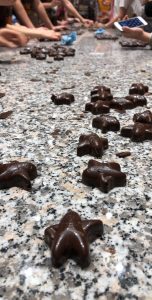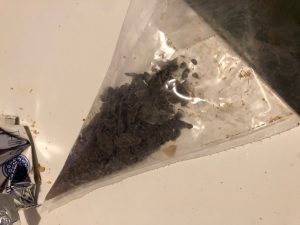We visited a chocolate museum/workshop on Monday. The museum displays the history of cocoa consumption, the techniques of making chocolate and things that are made of chocolate but seem like they are made of other materials. There is free chocolate everywhere in the museum. As I mentioned in my previous post, I have a disproportionally large stomach, and therefore I always appreciated places where I can eat as much food as I want. I paced myself, however, because I knew there would be more coming once we were in the workshop.
Cocoa beans, which are the raw material for chocolate, are not cultivated in France: they are mainly produced in tropical African, Asian and American countries. So French is not that unique in respect to chocolate: everyone’s chocolate is made of beans from countries such as Cote d’Ivoire, Ghana, Indonesia and Nigeria (Mattyasovszky, 2017). The French, however, create pieces of chocolate so pretty that they are worth building a museum for. I remember that my dad once brought me a box of chocolate from France years ago, and I could not eat it because it was so pretty. So I just kept them until they had gone bad. I would not expect to see a similar place in the US because people do not care too much about how their chocolate looks.
We went to the workshop after the museum. The chocolate expert made the process look easy, but it was not. We had to dump the warmed up liquid chocolate into the mold quickly before it cooled down and hardened. We had to hit the mold on the side with the spatula, and the melted chocolate just fell everywhere: on the table, on our hands, and on our cloth. I ate all the chocolate that landed on my hands. Then we added hazelnut filling and another layer of chocolate before putting it in the fridge to cool. The end result was not ideal, as half of my chocolate pieces were broken. But I took a lot of chocolate scratched from the table, so I was happy.

Do you know that one study has shown that eating cocoa flavanol (a component of chocolate) regularly might improve cognitive function in elderly people who have mild cognitive impairment (Desideri et al., 2012)? More studies found evidence of the potential cognitive benefit of chronic intake of cocoa flavanol (Socci et al., 2017). So I hope my brain will become healthier as I eat all the chocolate scratched from the table.

Reference
Desideri, Giovambattista, Kwik-Uribe, Catherine, Grassi, Davide, Necozione, Stefano, Ghiadoni, Lorenzo, Mastroiacovo, Daniela, . . . Ferri, Claudio. (2012). Benefits in cognitive function, blood pressure, and insulin resistance through cocoa flavanol consumption in elderly subjects with mild cognitive impairment: The Cocoa, Cognition, and Aging (CoCoA) study. Hypertension., 60(3), 794-801.
Mattyasovszky, M. (2015, April 23). Top 10 Cocoa Producing Countries. Retrieved from https://www.worldatlas.com/articles/top-10-cocoa-producing-countries.html
Socci, V., Tempesta, D., Desideri, G., De Gennaro, L., & Ferrara, M. (2017). Enhancing Human Cognition with Cocoa Flavonoids. Frontiers in Nutrition., 4, 19.
